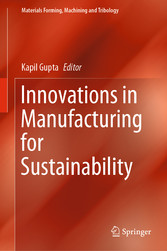Suchen und Finden
Service
Innovations in Manufacturing for Sustainability
Kapil Gupta
Verlag Springer-Verlag, 2018
ISBN 9783030032760 , 187 Seiten
Format PDF, OL
Kopierschutz Wasserzeichen
Preface
6
Contents
8
1 Dry and Near-Dry Machining Techniques for Green Manufacturing
9
Abstract
9
1 Introduction
10
1.1 Introduction to Cutting Fluids
10
1.2 Characteristics of Cutting Fluids
10
1.3 Types and Application of Cutting Fluid
11
1.3.1 Oil-Based Cutting Fluids
11
1.3.2 Aqueous-Based Cutting Fluids
12
1.3.3 Synthetic and Semi-Synthetic Cutting Fluids
13
1.4 Ecological Problems of Conventional Cutting Fluids
13
1.5 Newly Developed Environmental Friendly Cutting Fluids
15
1.5.1 Vegetable-Based Cutting Fluids
15
1.5.2 Gas-Based Coolant Lubricants
16
1.5.3 Chemical Additive-Enhanced Cutting Fluids
17
1.5.4 Nanoparticle-Enhanced Cutting Fluids
17
2 Cooling and Lubricating Techniques
18
2.1 Conventional Methods
18
2.1.1 Traditional (Flood/Wet) Cooling Technique
19
2.1.2 High-Pressure Cooling Technique
19
2.1.3 Mist Cooling Technique
19
2.1.4 Internal Tool Cooling
20
2.2 Advanced Green Manufacturing
20
2.2.1 Dry Machining
20
2.2.2 Near-Dry Machining
22
Minimum Quantity Lubrication (MQL)
23
Nanofluid Additives in Green Manufacturing
24
2.2.3 Comparative Study Between Dry Machining and MQL
25
3 Case Studies on Machinability Using Different Coolant Conditions
27
4 Summary
31
References
32
2 Cryogenic Machining
36
Abstract
36
1 Introduction
36
2 Experimental Procedure for Cryogenic Machining
40
3 Methods of Cryogenic Cooling
42
3.1 Pre-cooling of Workpiece
42
3.2 Indirect Cooling
43
3.3 Jet Machining
43
3.4 Cooling Treatment by Cryogenic Material
44
3.5 Cryogenic Minimum Quantity Lubrication
45
4 Effect of Cryogenic Machining
46
4.1 Influence of Cryogenic Cooling on Tool Life and Wear
46
4.2 Influence of Cryogenic Cooling on Tool and Workpiece Temperature
47
4.3 Influence of Cryogenic Machining on Material Properties
48
4.4 Influence of Cryogenic Machining on Friction
49
4.5 Influence of Cryogenic Conditions on Cutting Forces
51
4.6 Influence of Cryogenic Machining on Surface Finish and Dimensional Precision
52
4.7 Effect of Cryogenic Temperature on Microstructural Change of Tool and Workpiece Material
53
5 Comparison Between CO2 and LIN Cryogenic Cooling
55
6 Conclusion
56
References
57
3 Sustainability Issues in Electric Discharge Machining
60
Abstract
60
1 Introduction
61
2 Dielectric Fluid in EDM
62
2.1 Dielectric Supply Methods
63
3 Sustainability of EDM Process
64
3.1 Impact of EDM Process on Environment, Health and Safety
64
3.2 Technological and Economic Concerns of EDM Process
66
3.3 Sustainable EDM
66
4 Green or Biodielectrics for EDM
67
4.1 Experimental Methodology
68
5 Performance Analysis of Biodielectric Fluids for EDM
69
5.1 Effects on Material Removal Rate (MRR)
70
5.2 Influence of Current on Surface Roughness and Surface Hardness
73
5.3 Influence of Pulse-ON Time on Surface Roughness and Surface Hardness
74
5.4 Metallurgical Structure Analysis
74
6 Conclusions and Future Directions
78
References
79
4 Energy-Efficient Casting Processes
83
Abstract
83
1 Introduction
83
2 Metal Casting Fundamentals
85
3 Energy Efficiency Through Management
86
3.1 Management Practices in Foundries
86
3.2 Lean Manufacturing Concepts in Foundries
87
3.3 Examples of Lean Implementation in Foundries
89
4 Energy Efficiency Through Technology
91
5 Examples of Energy-Efficient Casting Implementations
93
6 “Small Is Beautiful” Approach
95
6.1 Auditing Framework
96
6.2 Data Visualisation Tool
97
7 Foundries of the Future: A Short Conclusion
101
Acknowledgements
102
References
102
5 Research Framework of Sustainability in Additive Manufacturing: A Case of Fused Deposition Modeling
105
Abstract
105
1 Introduction
106
2 Life Cycle Perspective
108
3 Research Framework
111
4 Case Studies
114
4.1 Case I
115
4.2 Case II
119
4.3 Case III
121
5 Discussions and Conclusions
126
Acknowledgements
127
References
127
6 Sustainability in Welding and Processing
130
Abstract
130
1 Introduction
130
2 Fusion Arc Welding
133
2.1 Shielded Metal Arc Welding
134
2.2 Gas Metal Arc Welding (GMAW), Gas Tungsten Arc Welding (GTAW) and Plasma Arc Welding (PAW)
135
2.3 Submerge Arc Welding (SAW)
136
3 Solid-State Welding Processes
138
3.1 Magnetic Field-Based Welding
138
3.2 Ultrasonic Welding
140
3.3 Friction-Based Welding and Processing
141
3.3.1 Friction Welding
141
3.3.2 Friction Stir Welding
142
3.3.3 Friction Stir Spot Welding
143
3.3.4 Friction Bit Joining
144
3.3.5 Friction Stir Extrusion
144
3.3.6 Friction Stir Processing
144
4 Laser-Based Welding and Processing
145
5 Summary
145
References
148
7 Green Machining of Thin-Wall Titanium Alloy
151
Abstract
151
1 Introduction
152
2 Experimental Work
157
3 Results and Discussion
159
3.1 Computation of Thin-Wall Natural Frequency and Vibration Analysis
159
3.2 Surface Quality
161
4 Membrane Technology
164
4.1 Potential and Handling of Membrane Technology
164
4.2 PVDF Membrane for Mitigation of Wasted Cutting Fluids
166
4.3 Experimental Set-up of PVDF Membrane Technology
167
4.4 PVDF Membrane Experiments Results
168
5 Conclusions and Future Directions
169
References
170
8 Sustainability Assessment-Based Comparative Evaluation of Precision Miniature Gear Manufacturing Processes
173
Abstract
173
1 Introduction
174
1.1 Motivation
175
2 Materials and Methods
176
3 Results and Discussions
178
3.1 Sustainability Assessment
178
3.2 Calculations of Process Sustainability Index (PSI)
179
3.3 Process Performance/Machining Environment Sustainability Components
181
3.4 Product Performance Sustainability Components
182
4 Conclusions
184
References
185
Index
187



